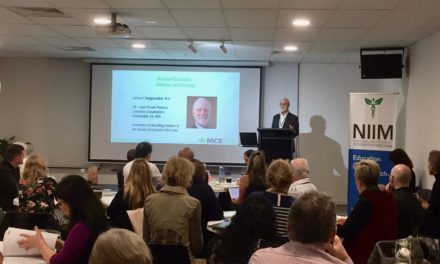From O’S News Service, July 7 Researchers at the University of Georgia have published a study in the July issue of Health Affairs showing that Medicare’s prescription drug benefit program saves money in states that have legalized marijuana for medical use. Authors Ashley Bradford and Dr. David Bradford —daughter and father, BTW— calculate that in 2013, patients using medical marijuana in 17 states enabled Medicare Part D to save US taxpayers $165.2 million that would have been spent on prescription drugs. As reported by the university’s media office, the Bradfords—
… combed through data on all prescriptions filled by Medicare Part D enrollees from 2010 to 2013, a total of over 87 million physician-drug-year observations.
They then narrowed down the results to only include conditions for which marijuana might serve as an alternative treatment, selecting nine categories in which the Food and Drug Administration had already approved at least one medication. These were anxiety, depression, glaucoma, nausea, pain, psychosis, seizures, sleep disorders and spasticity.
They chose glaucoma in particular because while marijuana does decrease eye pressure caused by the disease by about 25 percent, its effects only last an hour. With this disorder, they expected marijuana laws—as a result of demand stimulation—to send more people to the doctor looking for relief. And because taking marijuana once an hour is unrealistic, they expected to see the number of daily doses prescribed for glaucoma medication increase.
They were not disappointed. While fewer prescriptions were written for the rest of categories—dropping by 1,826 daily doses in the pain category and 265 in the depression category, for instance—the number of daily doses for glaucoma medication increased by 35.
“It turns out that glaucoma is one of the most Googled searches linked to marijuana, right after pain,” David Bradford said. “Glaucoma is an extremely serious condition” that can lead quickly to blindness. “The patient then goes into the doctor, the doctor diagnoses the patient with glaucoma, and no doctor is going to let the patient walk out without being treated.”
The lead author, Ashley Bradford, just finished college while her co-author occupies the Busbee Chair in Public Policy in the UGA School of Public and International Affairs. David Bradford expressed concern in the UGA press release about the hodge-podge of medical marijuana distribution systems and doctor-patient relationships:
“Doctors can recommend marijuana and in some states can sign a form to help you get a card, but at that point you go out of the medical system and into the dispensaries,” he said. “What does this mean? Do you then go less frequently to the doctor and maybe your non-symptomatic hypertension, elevated blood sugar and elevated cholesterol go unmanaged? If that’s the case, that could be a negative consequence to this.”
The researchers will explore these consequences further in their next study, Ashley Bradford said, which will look at medical marijuana’s effects on Medicaid, a joint federal and state program that helps with medical costs and typically serves an older population.
Ramifications
The Bradfords’ collection and analysis of readily available big data was simple and straightforward, and the significance of their findings cannot be overstated. Millions of Americans will soon be using cannabis instead of costly synthetic pharmaceuticals. The big private insurers undoubtedly understand, by now, that widespread use of cannabis as medicine reduces their payouts. Why aren’t they pushing against prohibition? Could it be that the insurance companies interconnect with the pharmaceutical companies via the banks?
The late Peter Lewis, who donated millions annually to the Marijuana Policy Project and to Graham Boyd at the ACLU, built Progressive Insurance into one of the industry giants. (It was a small company founded by his father. based in Cleveland.) Lewis once told Dennis Peron that the key to his success had been a tremendous insight: first-time speeders are a good insurance risk. Other insurance companies exploited drivers who got speeding tickets by steeply raising their rates. Lewis figured first-time speeders were actually competent drivers who got over-confident. By offering a relatively low rate to drivers with speeding offenses, Progressive snagged a big piece of the car-insurance market.
How long will it be until an insurance company factors in the health benefits to their clients of cannabis use, plus savings to the company in prescription drug costs, and offers a special “420 Discount?” Will they require documentation of regular, heavy use?
I figured that it was Peter Lewis himself who chose the actress to play Flo in the TV ad campaign that Progressive launched in 2008. Or else he told the casting agent, “Get me a Steph Sherer type.”





